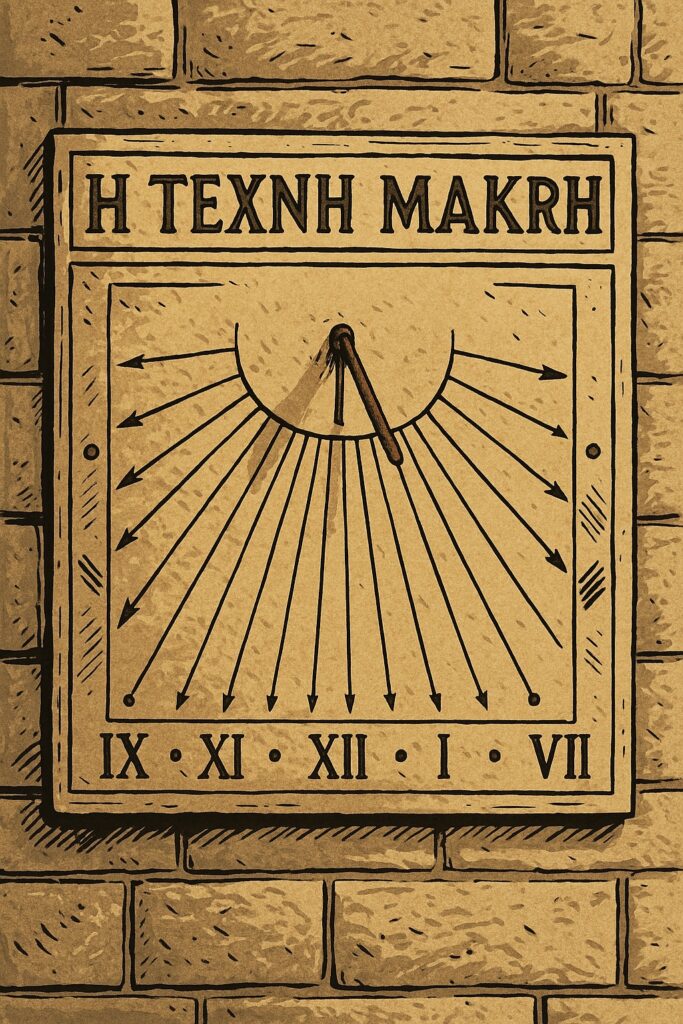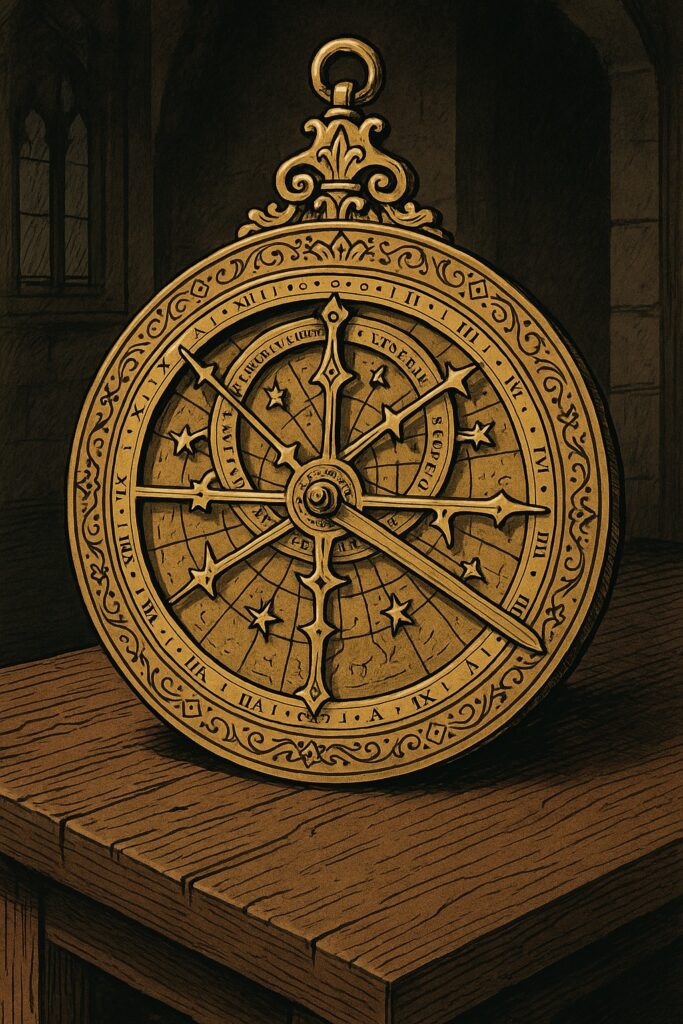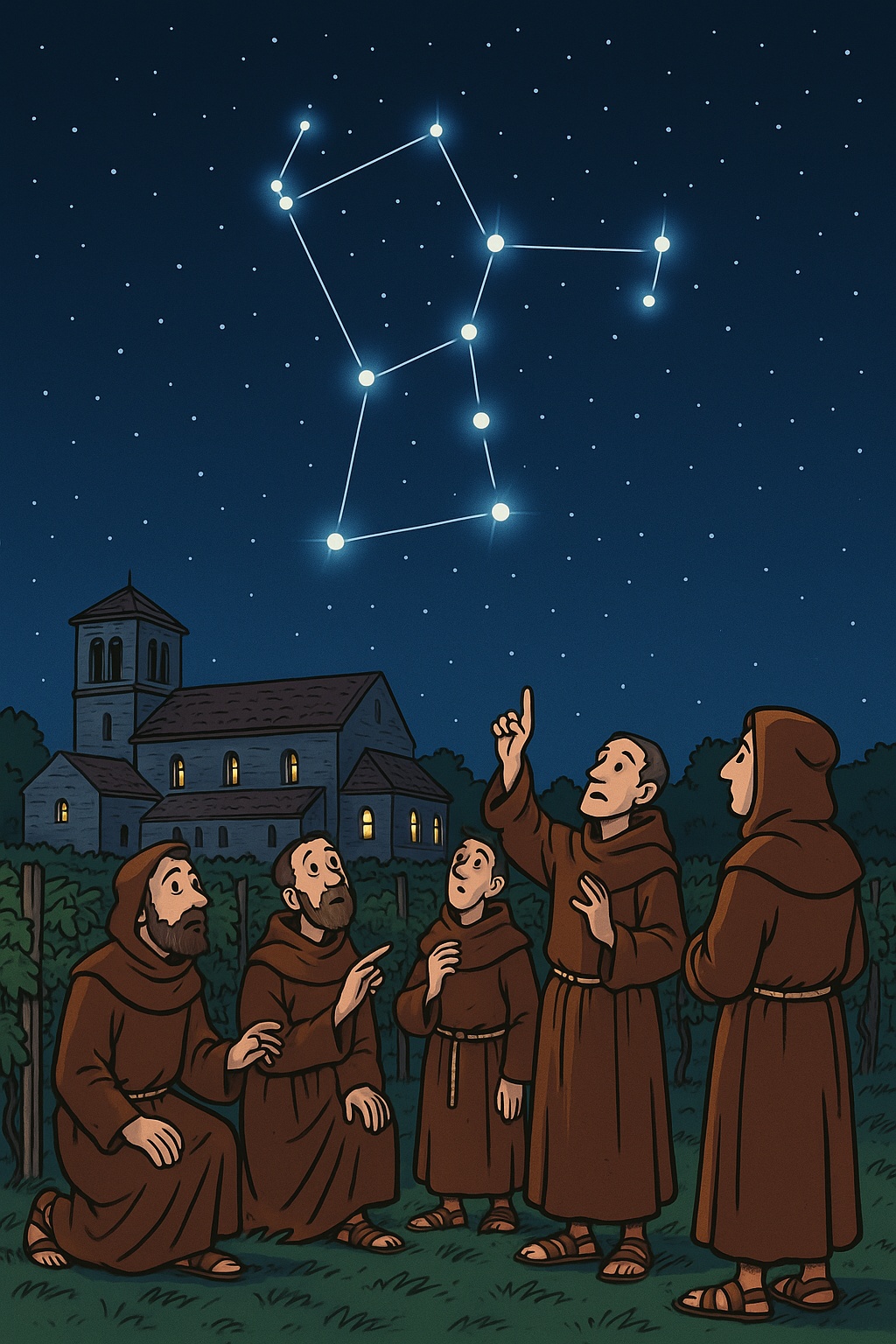Summary
From the serpentine Anglo-Saxon sundial still embedded in the wall of Escomb church (c. 700) to the eight-foot clock that once dominated the transept of St Albans (c. 1330), European monasteries served as observatories, libraries and workshops for astronomy for a full thousand years. Liturgical imperatives—above all the computus that fixes the date of Easter—forced monks to master celestial cycles; in the process they preserved classical science, adapted Islamic instruments and ultimately packaged astronomy into the textbooks that launched Europe’s first universities.
1 The Late-Antique Seedbed (5th – 6th centuries)
1.1 Capella and Cassiodorus
Martianus Capella’s allegorical De nuptiis fused astronomy with arithmetic, geometry and music, creating the fourfold quadrivium that monastic teachers would soon adopt.
Half a century later Cassiodorus, retiring to his Vivarium monastery, listed astronomia among the liberal arts essential for Scriptural exegesis and directed his scribes to copy Greek and Roman cosmological excerpts.
1.2 Scriptoria and the Survival of Texts
By 580 these excerpts travelled north with missionary monks; fragments of Macrobius, Pliny and Aratus turn up in Merovingian codices from Luxeuil and Corbie, evidence that the cloister library had already become a scientific archive.
2 Computus: Astronomy in the Service of Easter
2.1 Cycles before Bede
Dionysius Exiguus introduced a 532-year Paschal table at Rome in 525, combining a 19-year lunar and a 28-year solar cycle; Irish houses preferred an 84-year table, sparking the Easter controversy settled at Whitby in 664.
2.2 Bede’s De temporum ratione
Working at Wearmouth–Jarrow, Bede (673 – 735) reconciled the rival traditions, explained equinox drift, and supplied monks with ready-made tables and didactic diagrams; the treatise spread from Northumbria to Monte Cassino within a generation.
2.3 The Classical-Gregorian Algorithm
Modern restatements of medieval practice are epitomised by Gauss’s algorithm (Gregorian version shown), which encapsulates the same Metonic logic in modular arithmetic:
a = Y mod 19
b = Y mod 4
c = Y mod 7
k = Y // 100
p = (13 + 8k) // 25
q = k // 4
M = (15 – p + k – q) mod 30
N = (4 + k – q) mod 7
d = (19a + M) mod 30
e = (2b + 4c + 6d + N) mod 7
if d + e < 10:
Easter = 22 + d + e # March
else:
Easter = d + e – 9 # April
The constants M and N reproduce Bede’s 19/28 solution; the decision clauses mirror twelfth-century monastic emendations.

These were the kinds of sundials mounted on monastery walls. See the image above.
3 Marking the Hours: Instruments and Daily Observation
3.1 Sundials in Stone
Escomb’s three-notch dial marks Terce, Sext and None—the core daytime Offices defined by the Rule of Benedict—proving that by c. 700 monks routinely tracked solar altitude. Similar dials survive at Bewcastle, Ripon and Jarrow, each carved where the refectory porter could read it from the cloister walk.
3.2 Night Watches and Portable Tools
For the nocturnal Offices, sacristans used hand-held nocturlabes, calibrated candles or the rhythmic drip of cloister water-clocks; surviving chapter-house rules instruct the horologer to mend clepsydrae before Advent cold freezes the troughs.

The image above shows an astrolabe.
3.3 The Astrolabe Arrives—Andalusian Brass in the Cloister
In the later tenth century Gerbert d’Aurillac (future Pope Sylvester II) encountered the planispheric astrolabe while studying mathematics in Catalonia. He returned to Reims with a brass exemplar, wrote a short Liber de astrolabio and commissioned local metal-workers to replicate the device. By the early eleventh century abbots from Fleury to Canterbury were requesting “astrolabes for teaching the juniors the rising of the stars,” and monastic inventories begin to list the instrument alongside missals and chalices.
3.4 Astrolabes: Origin, Transmission and Monastic Practice
- Hellenistic Blueprint The astrolabe’s conceptual ancestry reaches back to Hipparchus and Ptolemy, who described stereographic projection and the rete-and-plate geometry needed to map a three-dimensional sphere onto a two-dimensional disk. No physical examples survive from antiquity, yet their mathematical recipes passed eastward with late-Roman scholars.
- Refinement in the Islamic World Between the eighth and tenth centuries Muslim astronomers in Baghdad, Damascus and Córdoba perfected the planispheric form, added azimuth lines, prayer-time curves and zodiacal calendars, and cast the first large bronze instruments. Andalusian artisans in particular standardised the elegant, star-shaped rete that would later dazzle European visitors.
- Portals of Transfer Monks met the astrolabe at three cultural frontiers: the Mozarabic churches of Catalonia, the Norman courts of Sicily and the Crusader states of Outremer. Pilgrims, diplomats and returning scholars carried both Arabic treatises and fully-furnished brass examples over the Pyrenees and up the Rhône corridor into Francia.
- Monastic Workshops Once inside the cloister, metal-working brothers reproduced the design in pewter or latten, sometimes engraving the hour lines in Latin, sometimes preserving the original Kufic star names. Benedictine houses at Reichenau, Hildesheim and St Albans left accounts of casting moulds, polishing wheels and tempering small iron alidades for sighting the Sun.
- Pedagogical Tool An astrolabe lesson typically began in the classroom: a master would rotate the rete until the star Regulus sat on the local meridian, then invite novices to read off the solar altitude, the length of the remaining daylight and the current “unequal hour.” In the cloister garth the same pupils measured the altitude of the Pole Star at opposite solstices to verify the teachings of De sphaera mundi.
- Liturgical Utility Beyond education, astrolabes provided quick determinations of sunrise, sunset and the beginning of each canonical hour. A sacristan could set the instrument for the Sun’s ecliptic longitude, swing the rule to the measured altitude and read Prime, Terce or Vespers without recourse to tables. Some surviving dials even carry engraved Dominical letters to cross-check computus cycles.
- Scientific Breakthroughs By the thirteenth century, monastic astronomers such as Abbot Richard of Wallingford used the astrolabe as a calibration standard for larger equatoria. Richard compared experimental lunar longitudes taken on his handheld instrument with the values produced by his giant Albion wheel, fine-tuning the gearing ratios that made the clock of St Albans the wonder of Christendom.
- Decline and Legacy The instrument remained a staple of monastic armaria until printed star charts and ring dials rendered it obsolete in the fifteenth century. Yet its instructional diagrams migrated directly into university textbooks, ensuring that every undergraduate of the arts faculty still learned to trace the rete long after brass astrolabes had vanished from the sacristy cupboard.
4 Anglo-Saxon Innovation
4.1 Wearmouth–Jarrow’s Glass and Gnomons
The twin monasteries imported coloured glass from Gaul, glazing south-facing transept windows to create stable gnomon walls on which heliacal arcs could be chalked each solstice. Bedan tables in local annals note first and last visibility of Arcturus, data he used to check calendar drift.
4.2 Chronicles and Meteors
The Anglo-Saxon Chronicle records a fiery “heaven-drake” in 793 and Halley’s Comet prior to Hastings in 1066; both notes were written by monastic scribes who linked celestial omens to political fortunes.
5 The Carolingian Consolidation (8th – 9th centuries)
5.1 Charlemagne’s Admonitio generalis
The capitulary of 789 ordered every abbey to teach the seven arts; copies of Boethius, Capella and Ptolemy flooded the new royal scriptoria, and Alcuin’s palace school at Aachen standardised astronomical diagrams for classroom use.
5.2 Illustrated Star Books
The Leiden Aratea (c. 816) recast Aratus’ constellations in shimmering Carolingian pigments; marginal glosses instruct novices how to locate Lyra “by the parallelogram of its stars,” revealing that the manuscript doubled as an observing guide.
5.3 Recording Eclipses
The Royal Frankish Annals list three lunar and one solar eclipse for 807, opening the entry with the celestial events before the year’s wars—clear proof that monks had moved from textual astronomy to predictive observation. In 798 the same annals remark that “Mars vanished from the heavens,” an almost certainly deliberate record of retrograde motion.
6 Extraordinary Phenomena and the Monastic Record
6.1 The St Gallen Supernova of 1006
At latitude 47 ° N the monks of St Gallen described a “new star, like a sun, dazzling in the south.” Their chronicle gives magnitude estimates and setting arcs that modern astronomers still use to model SN 1006.
6.2 Halley’s Comet and Political Portents
Norman chronicles link the 1066 apparition of Halley to Harold’s downfall; English monks compared its tail to a flaming sword, reinforcing the widespread belief that comets presaged regime change.
7 High-Medieval Instrument Makers
7.1 The Albion and Other Equatoria
Richard of Wallingford, elected abbot of St Albans in 1327, devised the Albion—a multi-plate equatorium able to compute lunar, solar and planetary longitudes without tables. His treatise circulated alongside Arabic models, showing monastic science in dialogue with the wider Mediterranean.
7.2 The St Albans Clock
Wallingford’s thirty-gear clock displayed unequal hours, lunar phases, eclipse warnings and even Thames tides; royal complaints survive that the abbot spent more on gears than on cloister roofs.
8 From Cloister to Lecture Hall
8.1 Sacrobosco’s Sphere
Written c. 1230 by the monk John of Holywood, De sphaera mundi distilled centuries of monastic astronomy into four lucid chapters; more than two hundred manuscripts and eighty incunabula testify to its function as Europe’s default university textbook until Copernicus.
8.2 Legacy of the Quadrivium
By 1400 the monastic quadrivium syllabus—inherited from Capella but refined by countless lecturers—had migrated wholesale into arts faculties at Paris, Bologna and Oxford, carrying computus tables, star maps and astrolabe exercises with it.
9 A Day (and Night) in the Observatory-Cloister c. 1100
Prime, sunrise. The sacristan consults the east-facing sundial; a shadow falls on the first notch. Bells ring. Records note the Sun’s declination for the equinox chart.
Terce. In the scriptorium, a novice inks red epact numbers into next year’s Paschal table, guided by Bede’s canon.
Sext. Under the cloister arcade the sub-prior adjusts the brass astrolabe, measuring solar altitude to set the Block sundial for winter. Results are copied into the Liber observationum.
Vespers. A water-clock inside the calefactory gurgles; the steward adds hot water to maintain flow, updating the float scale nailed to the oak case.
Complin. Stars rise beyond the orchard palisade. A brother sights the Pole Star through a hinged nocturlabe, rotates a pointer to match the position of Ursa Major, and estimates it is the third hour of the night.
Matins (pre-dawn). An eclipse watch tonight: two monks on the bell-tower compare the darkening Moon to Bede’s description, scratching a note—umbra plena at the third hour—into the margin of their chronicle.
This routine, multiplied by thousands of houses across a continent, turned prayer into data and devotion into the scaffolding of European observational astronomy.
10 Conclusion
Between 500 and 1500 CE European monasteries nurtured a seamless chain of astronomical practice. They inherited classical theory, married it to Christian ritual, recorded every remarkable light in the sky, built the first precision instruments north of the Alps, and finally exported their syllabus to the nascent universities. The “dark-age” cloister was, in reality, the first institution in post-Roman Europe where systematic empirical science, mathematics and engineering were pursued generation after generation—its bells tolling to the cadence of the stars.
